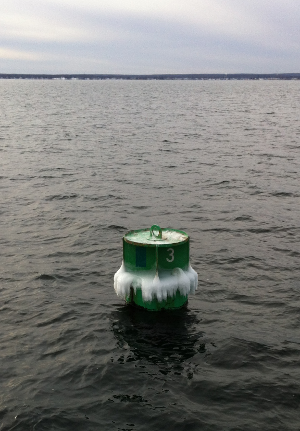Cold Water Testing
A small marker buoy with ice
When the temperatures start to drop well below freezing, most of the boat traffic on the Narragansett Bay disappears. Even if we would prefer to stay indoors by a fire or head for warmer waters, the FarSounder engineering team continues on water testing new sonar innovations. Recently, a few of the team boat tested FarSounder's latest 3D forward looking sonar equipment for the Argos 1000. Though setting up the equipment in the morning was quite frigid, we had beautiful calm waters, interacted with a pod of porpoises and spent a little time watching harbor seals bask on the rocks. We thought we'd share a little bit of a "typical" work day on the water.
Pole Mount Installation
Most of FarSounder's testing involves temporarily installing our sonar equipment on a rented vessel. The easiest way to do this is with a simple pole mount. For this test, we rented the R/V Cap'n Bert from the University of Rhode Island. This vessel is outfitted with a pole mount which can be attached to the bow. Their mount consists of a vertical pole with a flange on one end. The flange has a bolt pattern drilled into it and our Transducer Module mates to the flange with a simple adapter bracket we've designed. One day, when we have our own yacht or research vessel, we'll be able to permanently install the unit. Most likely this would be a simple retrofit installation.
The pictures below show some of the mount details. In the first picture, the Transducer Module is attached to the mounting bracket with the pole bolted on top. One of FarSounder's engineers can be seen attaching the cable to the back of the unit. The second picture shows the Transducer Module of the 3D FLS after installation. A rigid stay is attached to the hull just above the waterline and two guy lines help stabilize the pole.
Setting up the pole mount on a snow covered dock.
Transducer Module visible at about 1 meter depth with ice bits visible at the water's surface.
We've used this type of installation on boats all over the world. It works well and is quick to install. From a test point of view, this type of installation is really good as it generally experiences higher vibrations than a typical permanent installation and the Transducer Module is only 1 meter below the surface. So, if the forward looking sonar can work well in this environment it will generally work better in a more robust installation.
Obstacle Avoidance
Small marker buoy with a ring of ice.
1000m to the buoy as seen by our sonar.
When testing, some of the targets we like to look at with our sonars are navigation buoys. On this day, we had the water all to ourselves, so we were able to make some approaches towards buoys from a long distance without any other traffic getting in the way. Below are a couple of pictures of a buoy we saw. The first one is from a camera above the water. The second one is what our sonar saw from about 1/2 mile away (1000m).
Typically, these buoys are designed to be good radar reflectors. Surprisingly, they are not always the best sonar targets as their shape is often cylindrical. This shape creates a very good reflection but with a very narrow angular response. This means that the sounds waves will bounce of the buoy easily. However, if the buoy is not perfectly vertical, it may be stealthy, reflecting the sound waves away, not back towards the sonar.
Encounters with Marine Mammals
Though the Narragansett Bay is not generally known for marine mammals, in the wintertime a few seals can usually be found basking on rocks at low tide. As expected, we saw some just off of Newport. However, just before finding the seals, we had an exciting encounter with a small pod of harbor porpoise. It's rare to encounter porpoise so far up the bay and even more rare to encounter them in the winter. We essentially had a private show for about 10 minutes until they got bored and swam away.
Our sonars have been designed explicitly to be benign to marine life. They transmit with less power, less often and at higher frequencies than many generally accepted commercial echosounders. In fact, part of FarSounder's initial motivation to develop this technology was to help avoid whale ship strikes. Like fish-finders and sounders, porpoises can detect our sonar signals. However, we're much quieter than the sounds they themselves produce. Sometimes, porpoises evan "talk" back to us. Their pings are so loud and so frequent that they actually appear as interference to our sonars. When this happens, the porpoises' signals look like bands of targets at equal range across the sonar's field of view.
Returning to Port
At the end of our day of testing, we returned to port and uninstalled the equipment. We hurried to complete the demobilization before the sun set. During a successful day on the water like this, we generally collect about 100 GB of sonar data. This includes the raw hydrophone receiver signals, gps/heading information, and electronic time stamped notes. Back at our office, all of this information gets uploaded to a database system. The database allows us to query for recorded pings based on location, date-time, vessel speed, vessel heading, water depth, signal type and sonar serial number. Since we are continually working to improve our system's capabilities, our engineers can use these specific recordings for algorithm development.

